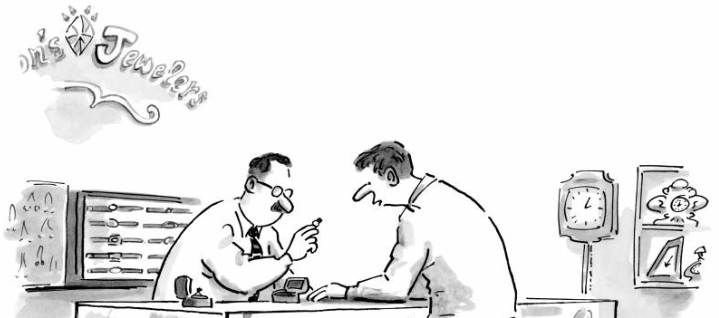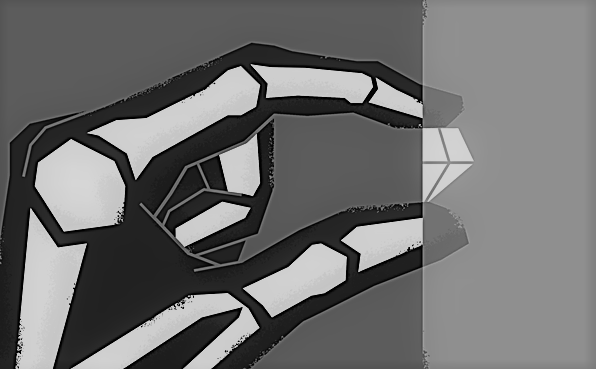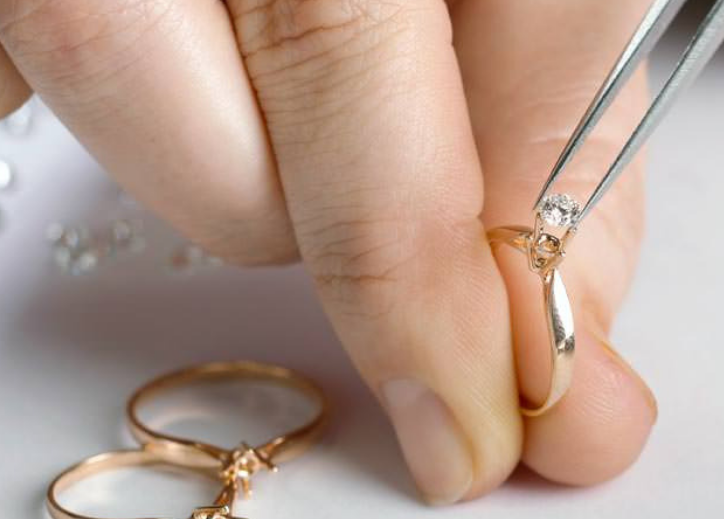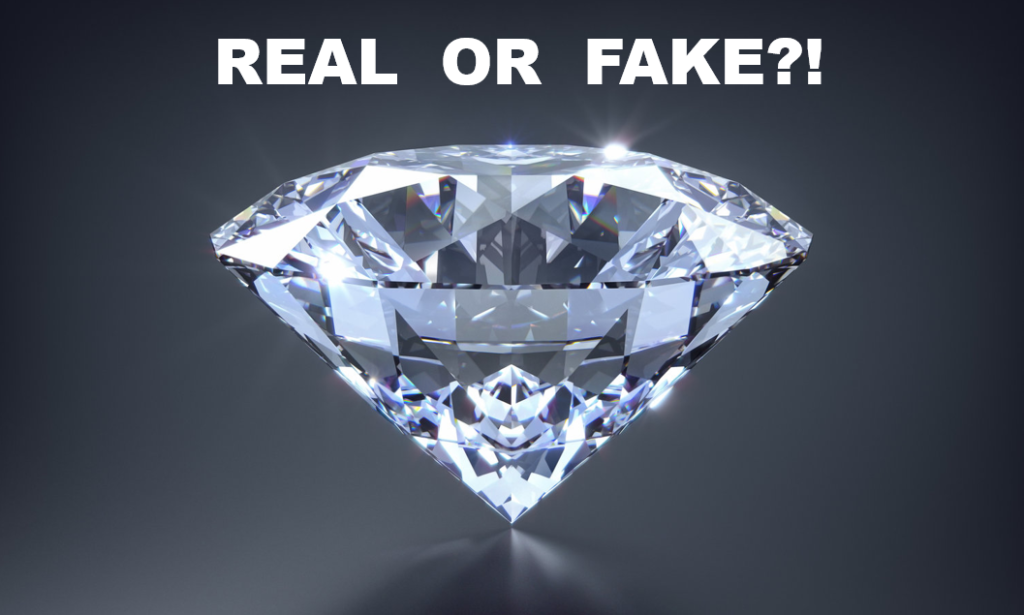While I was searching for my Fiancé’s engagement ring, one idea I had to get the most for my money was to purchase a high-quality diamond ring from a private party at a deep discount (on Craiglist, Ebay, or Facebook Marketplace). I planned to remove the diamond, and build my own custom ring around the original center stone. I did in fact, meet with multiple people who were selling their rings in this fashion. Some people had paper work to validate the authenticity of their center stone and some did not. With each person I met, I had the same question, “how do I know if this diamond is real or fake?” This question rung in my head even if the seller had Gemological Institute of America certifications (aka GIA – the top diamond certification company in the world), receipts, and a justifiable story of why they were selling their ring. I didn’t know if you could fake these documents or even if the documents were real, if the diamond they were selling me was the diamond in the paper work. I needed a quick and practical way to tell if these stones were authentic diamonds or not. There was too much money on the line. Here are 10 ways you can quickly and easily tell if a diamond is real or fake.
Quick Tips
- If you are meeting with a private party to buy a diamond or ring DO NOT bring the cash for the purchase. If you are satisfied with the product and decide you would like to purchase it, you can easily have the private party follow you to a bank nearby and complete the transaction there.
- Many people believe “the scratch test” ensures the validity of a diamond. Please DO NOT use this method to test a diamond as it is NOT reliable. This test involves scratching a diamond against a mirror to validate its authenticity. This is NOT reliable as there are many fake diamonds that will pass. Fake diamonds made of cubic zirconia or moissanite will easily defeat this test.
Reliable Ways to KNOW if a Diamond is Real or Fake
1) Go to a local jewelry store!
Gentlemen, this is the surest way to validate the authenticity of a diamond. If you are looking to buy a diamond from a private party via an online market place, you can easily arrange a meeting at a local jewelry store where you can have one of the staff members examine the stone free of charge. This method will also save you time as fraudulent diamond sellers, or con-men as I like to call them, will not meet you if they know their diamond is fake. I used this option almost every time I met with private parties to potentially buy a diamond or ring. One warning I should mention however, is that with this strategy you will run the risk of losing your deal. I have personally been in a situation where I negotiated an amazing deal with a private party only for the jeweler to hear the numbers, bid me up, and steal the deal. If you use this method, do your best to not mention the price you are paying for the stone so that you don’t lose the deal. Also, I recommend that you, yourself choose which jeweler to go to. I may be overly paranoid, but I would hate for there to be some sort of inside job where the jeweler is in on the scam. I recommend going to a more high-end establishment as they will be less busy, and in my experience, very willing to help.

2) Use a Thermal Conductivity Probe (aka “The Diamond Tester”)
This simple (and cheap) device will give you instant peace of mind when wondering whether a diamond is real or fake. This tool is used by gemologists to determine the thermal conductivity of gemstones. Diamonds naturally disperse heat rapidly when warmed (unlike fake diamonds) and the thermal conductivity probe will validate this instantly. If the stone you are testing disperses heat quickly, the stone is a real diamond (the light will turn green). If the stone disperses heat at a slow rate, the stone is not a diamond (the light will stay red). These devices are quite common as they are very affordable and accurate. There are many different thermal conductivity probes but here is a link to one you can pick one up for about $15 on Amazon. Bring it with you while you are searching for your diamond as it is quite small and portable. This is an especially good tool if you are unable to meet at a local jewelry store or have a jeweler validate a diamond’s authenticity.
3) Use a Loupe
A Loupe is a tool used by jewelers across the world. It is basically a powerful magnifying glass which will allow you to see a diamond at 10 to 60 times magnification. A Loupe will show you a diamond as you’ve never seen before. If the diamond is genuine you will be able to see small inclusions within the diamond or a code. Not all diamonds have these features, but the majority do. Unless you are dealing with a perfect IF (internally flawless) clarity diamond, which is unlikely as there are very few and they are extremely expensive, you will see small imperfections in the diamond created by substances trapped in the diamond while it was formed.

If the diamond is GIA (Gemological Institute of America) certified, it will be engraved with a code, only visible under magnification, and this code will match the paperwork that comes with the diamond. Fake diamonds will not have either of these features. You can pick up a Loupe for about $10 on Amazon and bring it with you to confirm whether a diamond is real or fake, here is a link. If you do not want to purchase one, you can go to a local jeweler and have them examine it with their own or ask to use theirs.
4) X – Ray Examination
If you would like a full and certain examination of your diamond, you can send your stone to a professional diamond lab for testing. A diamond lab will completely examine your stone, internally and at the molecular level to qualify it as a diamond. Their X – Ray machines will test a diamond for radiolucent molecular structure and radiopaque molecular structure. A true diamond will have a radiolucent structure while fake diamonds, like cubic zirconium or crystals, will have radiopaque features. This method will cost you around $100 depending on the size of your diamond, but you can be certain you will have the truth. A reliable recourse for this service is GIA.

5) The Fire Test
This test is for someone who is very serious about validating a diamond and not afraid of losing the stone if it is fake. For this test, you will need a lighter, some tongs or pliers, and a cold glass of water. Hold the diamond with the tongs and place the diamond in the flame for 30 or 40 seconds. Don’t worry, if the diamond you are testing is real it will be completely unharmed. After you’ve held the diamond in the flame for the allotted time, drop the diamond into the cold glass of water. If the diamond is fake it will at least crack, if not shatter completely. This will happen due to the weaker (fake) material not being able to handle the rate at which its molecules expand and contract from the extreme temperature change. Diamonds are formed through immense heat and extreme pressure, so this rudimentary test will have absolutely no effect on a real diamond.
Reliable Ways to INDICATE if a Diamond is Real or Fake
6) The Fog Test
The fog test is a simple indicator to whether a diamond is real or fake. For this test, take a loose diamond or a ring’s center stone and breath on it. This will fog up the diamond like you would a window in your car. If the fog disappears quickly the diamond is real. If the fog remains from 3 – 4 seconds before dissipating, the diamond is fake. This is due to a diamond’s ability to conduct heat much more efficiently than fake diamonds. One thing to be sure of before using this indicator is to clean the diamond thoroughly. If the diamond is not clean, the dirt and oils that build up on the diamond could make the fog last longer than it would otherwise. This could make a real diamond seem fake. Simply washing a diamond or ring with soap and lightly scrubbing the scum away should make a diamond clean enough to perform an accurate assessment. With that being said, I would use one or more of the other 10 methods listed here to further validate a diamonds authenticity.
7) The Transparency Test
The transparency test is another good indicator to whether a diamond is legitimate. For this test, you will need a newspaper, or any other type of white paper with words, and a well-lit space. Place the diamond upside-down over a letter on a page and look through its pavilion. If you are able to read the letter through the pavilion of the diamond, there is a high chance your diamond is fake. The letter should appear blurry and fragmented if the diamond is real. This is due to the highly reflective facets on the diamond that should cause the reflection to be disjointed. For this test you should also be sure to clean the stone beforehand. An unclean stone can alter the results of the test and could make a fake diamond appear genuine. Like with the fog test, this test is also an indicator. I would do further investigation to be sure a diamond is real.
8) The Floating Test
This is another simple test to indicate whether a diamond is real but will only work if you are dealing with a loose diamond. For the floating test, you will only need the diamond and a glass of water. Diamonds have a very high density and because of this they will sink in water very quickly. If you place the stone you are testing in a glass of water and it sinks to the bottom quickly, you know that the stone could be a diamond. If the stone floats or sinks very slowly, the stone is definitely not a diamond. From this point, you can do further testing to completely verify the diamond’s legitimacy.
9) Examine the Setting & Mount
As you all know, diamonds are an extremely valuable stone. Therefore, diamonds are set in precious metal setting that are marked for authenticity. This test is another great indicator on the legitimacy of a diamond. While examining a real diamond setting and mount, no matter the style, you will most likely be looking at yellow gold, white gold, or platinum. These types of metal will be marked with letters and numbers indicating which kind and of what grade you have. For an example, gold will be marked with 10K, 14K, or 18K indicating the grade of gold used for the setting.

Platinum will be marked with the letters PT, PLAT or the numbers 585, 770, 900, and 950. If you see these markings, the diamond is real. If you see the letters CZ on the setting or mount, the stone is cubic zirconia, which is a fake diamond. If you do not see any markings, you should be cautious and bring the ring to a jeweler to further examine.
10) The Sparkle Test
The sparkle test is a good indicator to whether a diamond is real or fake. For this test you won’t need any other equipment than your eyes. Make sure you have cleaned the diamond you are examining and simply hold the diamond in normal light. Watch how the light reflects off of the stone. You will see bright shimmers of white and colored light reflecting off the stone. A real diamond will shine beautifully like nothing else. If you have a real diamond to examine (maybe your mom’s or friend’s) then compare it to a fake diamond, you will notice a dramatic difference. Even cubic zirconium, the greatest diamond impersonator, will not shine as a real diamond does. As this test is an indicator, you should do further investigation to make sure your analysis is correct.
Conclusion
Gentlemen, the most convenient and sure way to know if a diamond is real or fake is to go to your local jeweler. On my own search for a diamond from private parties, this is the most common method I used. In the end, I did not end up buying my Fiancé’s diamond from a private party. I found my diamond online and this was much more convenient, affordable, and by far the best option overall. Buying from a private party does give you the most opportunity for you to get the most for your money but you do risk the chance of buying a diamond that is fake or even stolen. If you would like to see what is available online, check out James Allen by clicking here.



